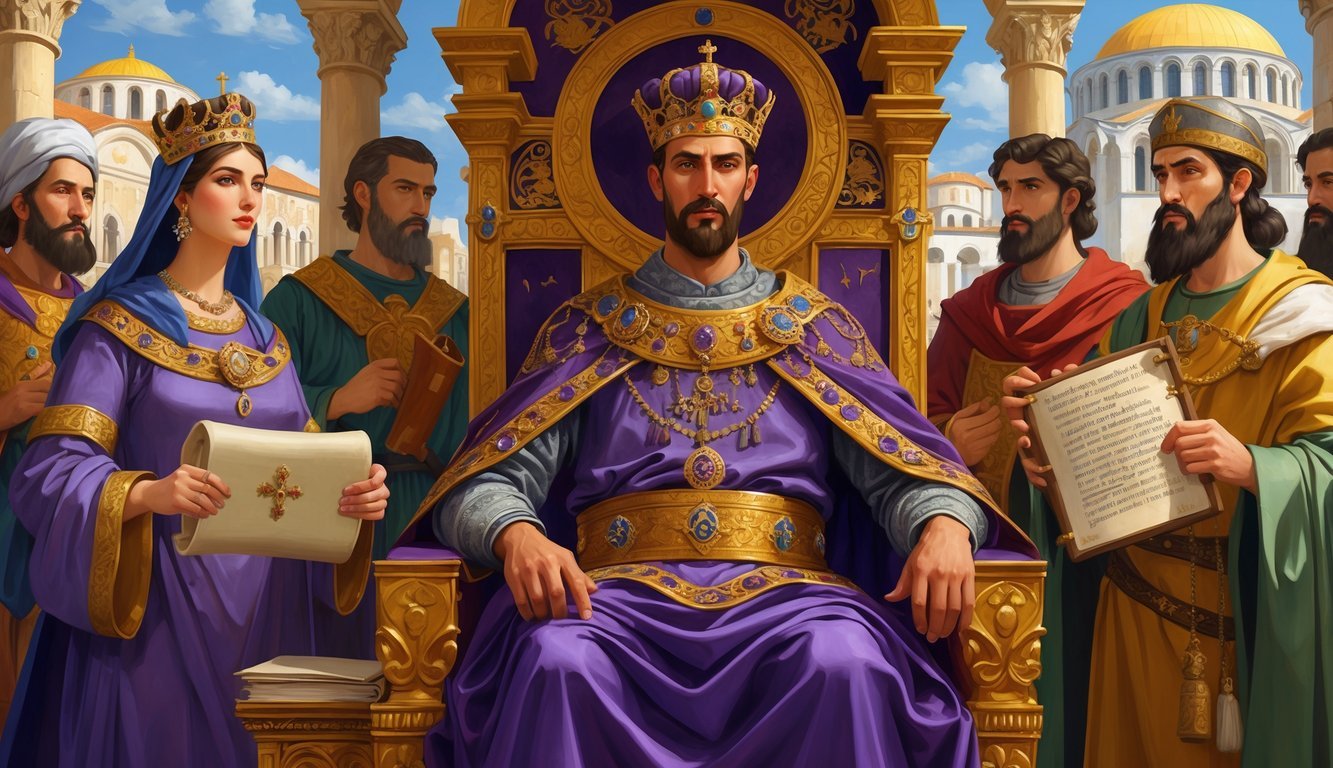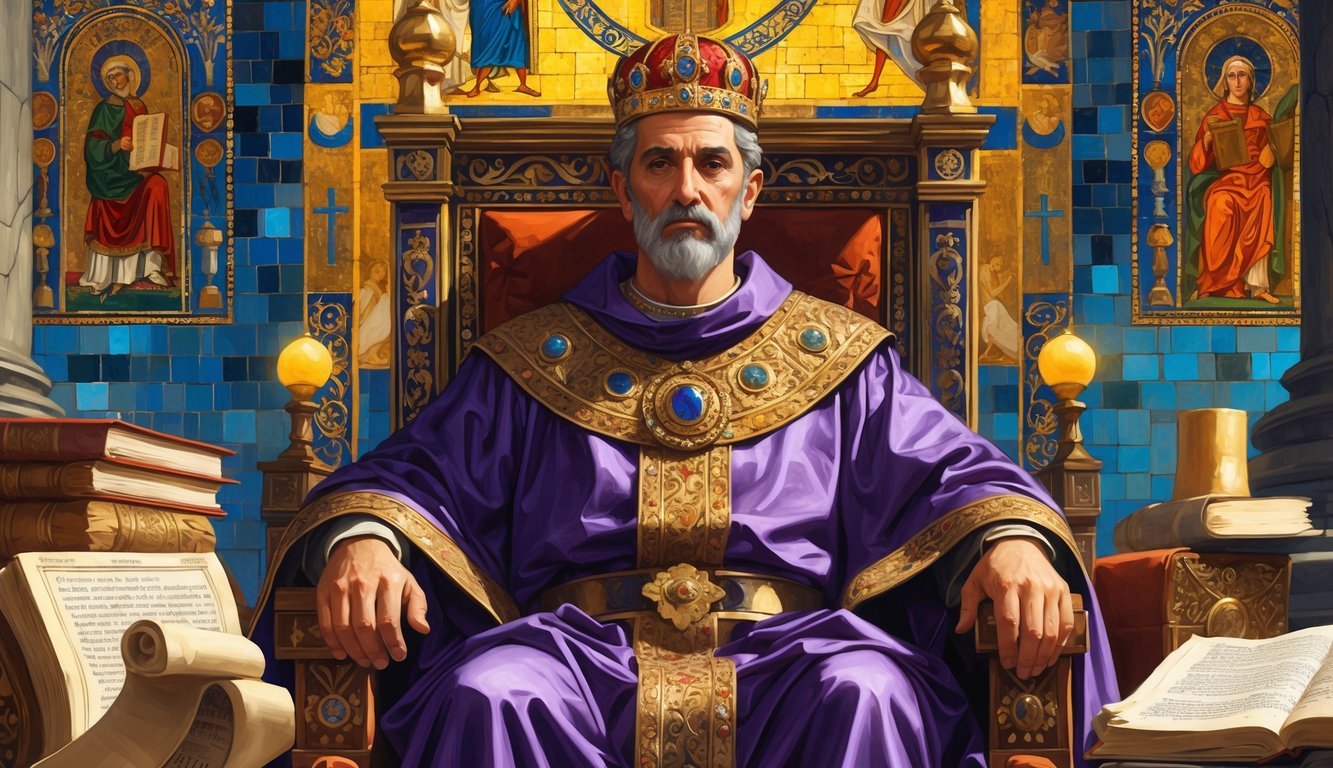PsychNewsDaily Publishers
100 Summit Drive
Burlington, MA, 01803
Telephone: (320) 349-2484
PsychNewsDaily Publishers
100 Summit Drive
Burlington, MA, 01803
Telephone: (320) 349-2484
Justinian I, Byzantine Emperor from 527 to 565, is renowned for his legal reforms, military campaigns, architectural achievements, and significant influence on Eastern Orthodox Christianity.

Justinian I stands as one of the most famous emperors of the Byzantine Empire. He ruled from 527 to 565.
People mostly remember him for creating a clear, lasting code of laws that shaped future legal systems. Even though he started out in a pretty modest family, Justinian climbed his way up to become a powerful leader who truly changed history.
Let’s talk about his early life, his path to the throne, and the big things he did while ruling. From rebuilding cities to making laws, Justinian’s work still ripples through the world today.
This biography gives you a look at the key events that made him such a strong—and sometimes controversial—ruler.

Let’s look at Justinian’s background and how he became one of the most important rulers of the Byzantine Empire.
His early years definitely shaped his path to becoming emperor and changing the Eastern Roman Empire.
Justinian was born around 482 CE in a village called Tauresium, in Illyria, which belonged to the Eastern Roman Empire back then. He didn’t come from wealth or nobility; his parents were peasants.
His uncle, Justin, stepped in as a protector and guide.
His mother’s name was Vigilantia. Even though he started out with little, Justinian learned both Latin and Greek, which turned out to be super helpful when he became a ruler.
His family didn’t have much, but those connections—especially with his uncle—opened doors for him in the empire.
| Fact | Detail |
|---|---|
| Birth Year | Around 482 CE |
| Birthplace | Tauresium, Illyria |
| Family Status | Peasant family |
| Important Relative | Uncle Justin |
Justinian’s story picked up speed after his uncle Justin joined the army and eventually became emperor. Justinian followed, got an education, and started working in government.
He kept growing more powerful and well-known.
In 527 CE, after Justin died, Justinian became co-emperor and soon took over as the sole ruler of the Byzantine Empire. Picture the imperial palace in Constantinople, where he began making big decisions that would shape the empire’s future.
His journey to the throne started with his uncle’s support and his own hard work before he finally became emperor.

During Justinian’s reign, he shaped law, led important battles to regain lands, managed religion and government, and changed architecture in some pretty lasting ways.
His rule was packed with action.
Justinian I gets credit for creating the Corpus Juris Civilis, or the Justinian Code. He and his team organized and updated Roman law, which had been confusing and scattered.
The code included four main parts:
This legal system shaped many modern laws and made justice easier to apply across the Eastern Roman Empire. Justinian’s chief advisor, Tribonian, led a lot of this work.
Justinian wanted to restore lands once held by the Western Roman Empire. His generals, Belisarius and Narses, led the charge against tough enemies.
They beat the Vandal Kingdom in North Africa and took back Italy and Sicily from the Ostrogoths. They also defeated the last Vandal king, Gelimer.
But the wars drained resources, and holding onto those territories wasn’t easy.
Justinian’s armies also fought the Sassanid Empire under King Khosrow in the east, and faced off with Bulgars, Franks, and Slavs near the borders.
Justinian worked closely with Empress Theodora to strengthen Christianity in the empire. He supported the Eastern Orthodox Church and tried to limit beliefs like Monophysitism and Arianism, which he saw as threats.
The Fifth Ecumenical Council happened during his reign to help settle church disagreements.
He also had to deal with the Nika Riot in 532, when people revolted at the Hippodrome. Justinian’s tough response kept him on the throne, and Theodora encouraged him to stay when things got rough.
One of Justinian’s biggest achievements is the stunning Hagia Sophia in Istanbul, built after the Nika Riot. The church has a massive dome and beautiful mosaics.
It’s become a model for later churches.
You’ll also find the Basilica of San Vitale and the Church of Saints Sergius and Bacchus, which really show off Byzantine architecture at its best.
His building projects showed off the empire’s power and culture. They included public works like the Hippodrome and fancy diptychs (decorated panels), helping make Constantinople a true city of its time.

Let’s answer some common questions about Justinian I’s achievements, his legal work, culture during his rule, and his personal life.
You’ll also get a sense of the challenges he faced as emperor.
Justinian I is best known for expanding the Byzantine Empire and trying to restore the old Roman lands.
He built the Hagia Sophia, a famous church in Constantinople, and strengthened the empire’s military.
He created the Corpus Juris Civilis, a new set of laws that influenced legal systems for centuries.
Justinian also supported art, architecture, and the Christian religion during his reign.
Justinian got his education in Constantinople and trained in law and administration.
He started from a humble background but rose to power through hard work and learning.
His wife was Theodora, a former actress who became empress.
She was a strong advisor and helped shape his policies, especially for women’s rights.
Justinian faced wars, a major plague, and riots in the empire.
Some people called him cruel because of harsh punishments and court politics during his rule.
Justinian died in 565, probably from natural causes.
Once he was gone, the empire gradually lost the territories he had worked so hard to reclaim.